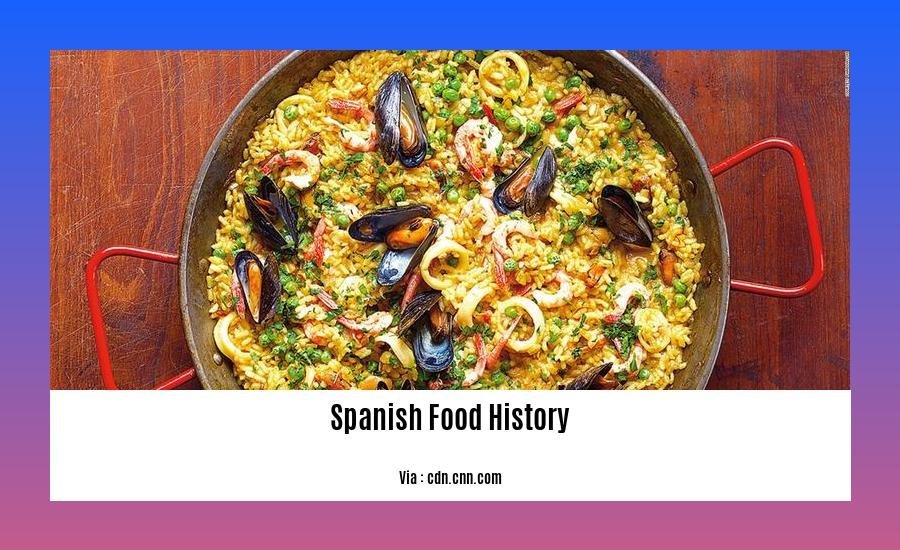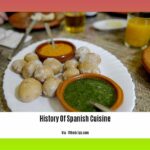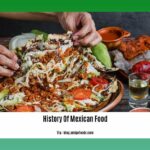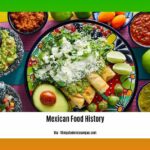Embark on a tantalizing journey through the culinary history of Spain in our article, “Discovering the Culinary Treasures of Spain: A Journey Through Spanish Food History.” Delve into the rich tapestry of flavors, traditions, and cultural influences that have shaped Spanish cuisine, from its ancient roots to its modern-day innovations. Join us as we uncover the stories behind iconic dishes, explore regional specialties, and celebrate the passion that drives Spanish gastronomy.
Key Takeaways:
Spanish cuisine is renowned for its remarkable regional diversity, offering distinctive culinary traditions in each region.
The extensive use of olive oil serves as the foundation for many vegetable sauces known as sofritos.
Herbs, such as parsley, oregano, rosemary, and thyme, are commonly employed to enrich flavors.
Garlic holds a prominent place, adding a distinct taste to various dishes.
Chicken, pork, lamb, and veal are frequently featured meats in Spanish cuisine.
Fish and seafood are celebrated ingredients, highlighting Spain’s coastal influence.
Tapas and pinchos, small bites and appetizers, are deeply rooted in Spanish bar and cafe culture, offering a delightful array of culinary experiences.
The historical background of Spanish cuisine is shaped by ancient influences, including the introduction of vineyards and olive oil production by the Greeks and Phoenicians.
Spanish cuisine has gained global recognition through the innovative and influential work of renowned chefs like Ferran Adrià, Juan Mari Arzak, and Santi Santamaría, who have revolutionized modern gastronomy.
Spanish Food History: A Journey Through Flavors and Traditions
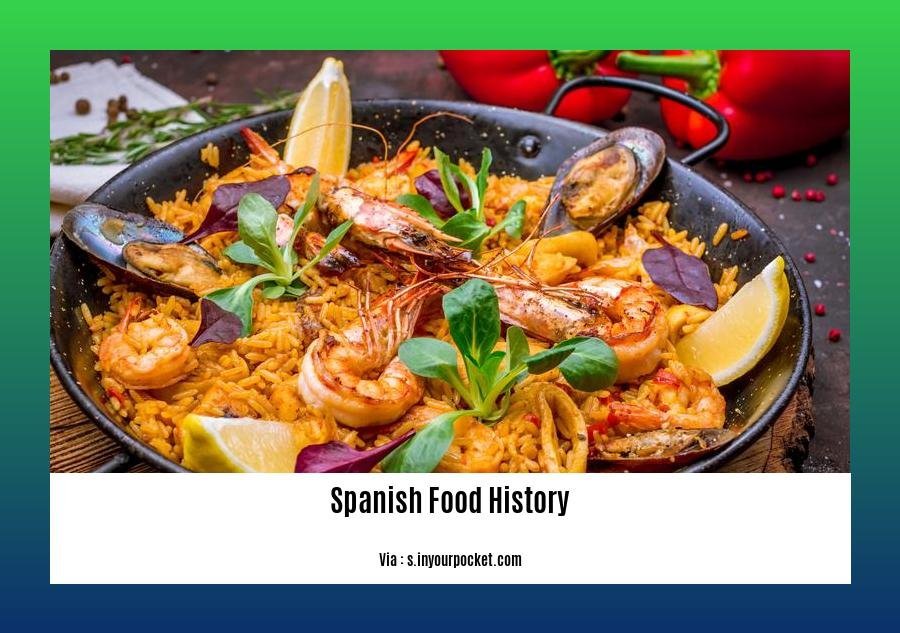
Spanish cuisine is a diverse tapestry of flavors and tradition. From the sun-kissed vineyards of the Mediterranean coast to the rugged mountains of the north, each region of Spain holds its unique culinary treasures. In this journey through Spanish food history, we will explore the fascinating evolution of Spanish cuisine and the cultural influences that have shaped its distinct character.
A Culinary Crossroads
Spain’s rich Spanish food history is a testament to its vibrant cultural heritage. The country’s strategic location has made it a crossroads of civilizations, with each culture leaving its mark on the culinary landscape. From the ancient Romans who introduced the grapevine to the Phoenicians who brought olive trees, Spain’s cuisine has been influenced by a myriad of cultures, blending Roman, Greek, Moorish, and Jewish culinary traditions.
Olive Oil: The Golden Elixir
Olive oil, a cornerstone of Spanish cuisine, has been revered since ancient times. The Greeks and Phoenicians introduced olive trees to the Iberian Peninsula, and the Romans further cultivated the art of olive oil production. Today, Spain is one of the world’s largest producers of olive oil, and its golden elixir is used extensively in Spanish cooking, forming the base of many flavorful sauces and dishes.
Herbs and Spices: A Symphony of Aromas
The use of herbs and spices is another defining characteristic of Spanish cuisine. The sunny climate of Spain favors the growth of aromatic herbs like parsley, oregano, rosemary, and thyme, which are liberally used to enhance the flavors of dishes. Garlic, another essential ingredient, adds a distinct savoriness to Spanish cooking, making it an indispensable part of the culinary repertoire.
From Tapas to Paella: A Culinary Mosaic
Spanish cuisine is celebrated for its delightful variety of dishes, from the humble tapas to the iconic paella. Tapas, small snacks or appetizers, are a beloved part of Spanish bar and cafe culture. These bite-sized treats can range from simple olives to elaborate seafood creations, showcasing the culinary diversity of Spain. Paella, a saffron-infused rice dish with seafood and meat, is another culinary masterpiece. Originating from the Valencia region, paella has become a symbol of Spanish cuisine, enjoyed by locals and visitors alike.
The Evolution of Spanish Cuisine
Spanish cuisine has undergone significant transformations throughout history. The introduction of New World ingredients, such as tomatoes, potatoes, and chocolate, by Spanish conquistadors had a profound impact on Spanish cooking. These ingredients, now staples of Spanish cuisine, added new flavors and textures to traditional dishes, enriching the culinary landscape.
Modern Gastronomy: A Culinary Revolution
In recent decades, Spanish cuisine has witnessed a culinary revolution, with renowned chefs like Ferran Adrià and Juan Mari Arzak pushing the boundaries of gastronomy. These culinary innovators, along with a new generation of chefs, are experimenting with avant-garde techniques, molecular gastronomy, and fusion cuisine, creating a new era of Spanish gastronomy that is both innovative and rooted in tradition.
Through its rich tapestry of flavors and traditions, Spanish food history tells a story of cultural exchange and culinary evolution. From ancient influences to modern innovations, Spanish cuisine has emerged as a vibrant and diverse culinary landscape that continues to captivate the taste buds of food lovers worldwide.
Explore thai food’s origins and evolution, as well as the intricacies of its unique flavors and culinary techniques that have shaped its reputation as one of the world’s most beloved cuisines. Delve into the rich history of traditional Mexican clothing and discover the cultural significance and symbolism behind each intricate design and vibrant color, embodying the nation’s rich heritage.
Spanish Cuisine Description
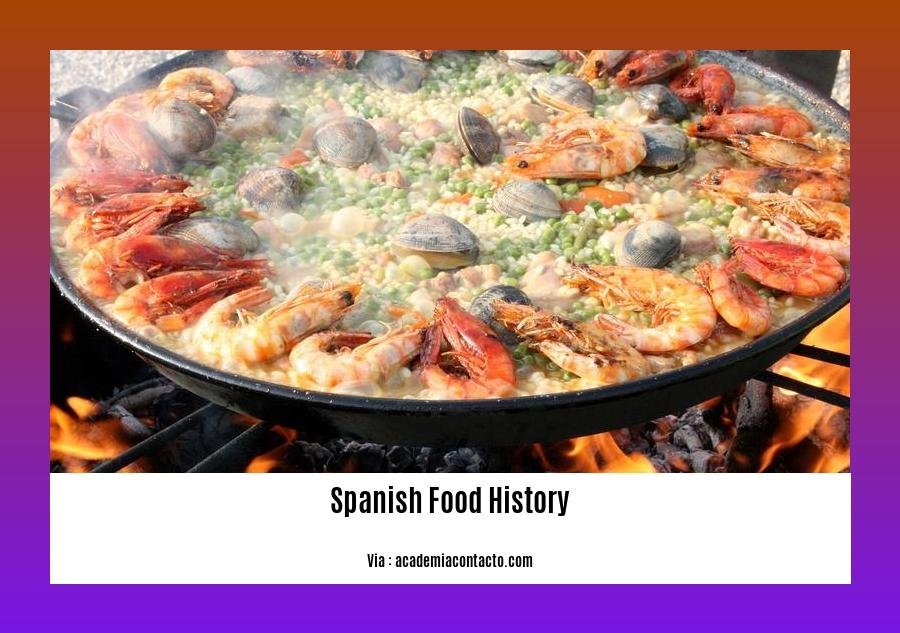
Let’s embark on a culinary expedition to savor the rich tapestry of Spanish cuisine, its historical roots, and its global impact.
A Heritage of Diverse Flavors
Spain, with its diverse regions, offers a culinary journey like no other. From the fiery flavors of Andalusia to the sophisticated dishes of Catalonia and the hearty stews of Castile and Leon, each region boasts unique specialties that reflect its history, geography, and culture.
Olive Oil: The Golden Elixir
Olive oil, a cornerstone of Spanish Cuisine Description, is deeply intertwined with Spain’s history and identity. As the world’s leading producer, Spain’s olive trees have been gracing its landscapes for centuries, giving rise to a diverse range of oils that enhance dishes with their fruity aromas and flavors.
A Culinary Odyssey: From Antiquity to the Modern Era
The Spanish Cuisine Description has been shaped by a captivating blend of cultures. In antiquity, the Greeks and Phoenicians introduced olive oil production and viticulture, while the Romans brought a taste of their culinary traditions to the Iberian Peninsula. The Visigoths influenced dairy consumption, and the Arabs introduced new techniques and ingredients like rice, sugar cane, and spices, leaving an indelible mark on Spanish cuisine.
Paella: A Culinary Legacy
Undoubtedly, paella is the culinary icon of Spain. This vibrant rice dish, originating from the eastern region of Valencia, showcases the country’s love for rice, saffron, and seafood, reflecting the region’s agricultural heritage and coastal influences.
Key Takeaways:
- Spanish cuisine offers a diverse tapestry of regional culinary traditions, each boasting unique flavors and specialties.
- Olive oil, a hallmark of Spanish Cuisine Description, is widely used in cooking and lends a distinctive flavor profile to dishes.
- The evolution of Spanish Cuisine Description has been influenced by various cultures, including the Greeks, Phoenicians, Romans, Visigoths, and Arabs, each leaving their mark on culinary traditions.
- Paella, a symbol of Spanish gastronomy, originated in Valencia and embodies the country’s love for rice, saffron, and seafood.
References:
- Spanish Cuisine – Wikipedia
- History of Spanish Cuisine – Spain.info
History of Spanish Food
Spanish cuisine, an exquisite symphony of flavors and aromas, reflects a diverse tapestry of cultural influences that have shaped the country’s gastronomic heritage. Embark on a culinary voyage through the annals of Spanish cuisine, discovering the rich history behind its iconic dishes and traditions.
The Phoenicians and Greeks: Laying the Foundation
The tale of Spanish cuisine begins with the arrival of the Phoenicians and Greeks, who introduced vineyards and olive oil production to the Iberian Peninsula, leaving an indelible mark on the country’s culinary landscape. Olive oil, the golden elixir of Spanish cooking, became a staple ingredient, lending its distinctive flavor to countless dishes.
The Moors: A Culinary Legacy
The Moors, with their mastery of spices and innovative cooking techniques, left an enduring legacy on Spanish cuisine. They introduced rice, a grain that would become central to many beloved Spanish dishes, including the iconic paella.
The Discovery of the Americas: A New World of Flavors
The discovery of the Americas marked a pivotal moment in Spanish culinary history. The influx of new ingredients from the New World, such as tomatoes, potatoes, corn, and chocolate, revolutionized Spanish cuisine, infusing it with vibrant flavors and textures.
Regional Diversity: A Tapestry of Tastes
Spain’s diverse geography and climate have given rise to a rich tapestry of regional cuisines, each boasting unique flavors and specialties. From the seafood-rich dishes of the coastal regions to the hearty stews of the interior, Spanish cuisine showcases a remarkable array of regional culinary identities.
Key Takeaways:
- Spanish cuisine reflects a rich tapestry of cultural influences, from the Phoenicians and Greeks to the Moors and the New World.
- Olive oil holds a central place in Spanish cuisine, lending its distinctive flavor to countless dishes.
- The discovery of the Americas introduced new ingredients to Spain, revolutionizing its cuisine and infusing it with vibrant flavors and textures.
- Spain’s diverse geography and climate have given rise to a rich tapestry of regional cuisines, each with unique flavors and specialties.
- Spanish cuisine is a testament to the country’s rich history, a culinary journey that continues to evolve and captivate taste buds worldwide.
References:
- Spanish Cuisine
- History of Spanish Cuisine
FAQ
Q1: What historical periods have significantly influenced Spanish cuisine?
A1: Spanish cuisine has been shaped by various historical periods, including antiquity when the Greeks and Phoenicians introduced olive oil production and the cultivation of vineyards. The Roman era brought the use of wheat, grapes, and olives as staple meal products, while the Visigoths introduced fermented milk and avoided mixing water and wine. The Hispano-Muslim period saw the introduction of new irrigation techniques and ingredients like rice, sugar cane, watermelon, lemon, oranges, sorghum, spinach, eggplant, peach, apricot, and saffron.
Q2: How did the discovery of the Americas impact Spanish cuisine?
A2: The discovery of the Americas in 1492 revolutionized Spanish cuisine as new ingredients from the Americas, such as tomatoes, potatoes, corn, and chocolate, were introduced. These ingredients significantly altered the Spanish diet and became integral parts of many traditional Spanish dishes.
Q3: What is the significance of olive oil in Spanish cuisine?
A3: Olive oil is a cornerstone of Spanish cuisine, with Spain being the world’s largest producer. It is extensively used in cooking, forming the base of many vegetable sauces called sofritos. Olive oil adds a distinct flavor and aroma to Spanish dishes and contributes to the Mediterranean diet’s health benefits.
Q4: What are some common ingredients and flavors used in Spanish cooking?
A4: Spanish cuisine utilizes various ingredients and flavors to create its diverse dishes. Olive oil, garlic, and herbs such as parsley, oregano, rosemary, and thyme are commonly used to enhance the flavors of Spanish cooking. Common meats include chicken, pork, lamb, and veal, while fish and seafood are popular due to Spain’s coastal location.
Q5: What are some innovations that Spanish chefs have contributed to modern gastronomy?
A5: Spanish chefs, such as Ferran Adrià, Juan Mari Arzak, and Santi Santamaría, have made significant contributions to modern gastronomy. They have challenged traditional cooking techniques and ingredients, experimenting with innovative ideas and flavor combinations that have redefined the culinary landscape. Their work has garnered international recognition and helped elevate Spanish cuisine to its current global prominence.
